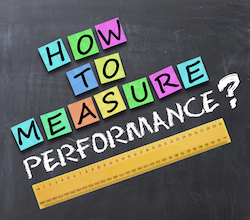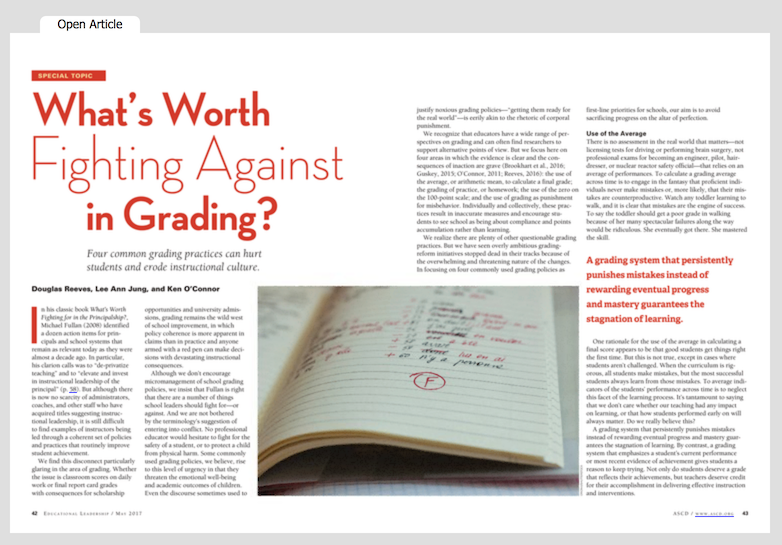 Returning to the office after some wonderful weeks facilitating Instructional Rounds, I was worried that my learning might shift into a lower gear. Before I even had time to contemplate what I might do to keep that from happening, I looked in my inbox and discovered mail—three new books, the latest issue of Harvard Business Review, and the May issue of Educational Leadership.
Returning to the office after some wonderful weeks facilitating Instructional Rounds, I was worried that my learning might shift into a lower gear. Before I even had time to contemplate what I might do to keep that from happening, I looked in my inbox and discovered mail—three new books, the latest issue of Harvard Business Review, and the May issue of Educational Leadership.
 As always, I reached for the copy of Educational Leadership first (noting this month’s theme is “Lifting School Leaders”) and immediately turned to Carol Ann Tomlinson’s monthly EL column One to Grow On.
As always, I reached for the copy of Educational Leadership first (noting this month’s theme is “Lifting School Leaders”) and immediately turned to Carol Ann Tomlinson’s monthly EL column One to Grow On.
In her latest piece, “Shining a Light on Leadership,” Tomlinson surfaces three education practices that she believes effective principal and teacher leaders must possess: (1) Leading from a Vision; (2) Minding the Process; and (3) Servant Leadership.
Three Practices of Effective Leaders
1. Leading from a Vision
Tomlinson turns to one of her favorite thought leaders, Thomas Sergiovanni, who identified five different platforms of authority:
✻ Bureaucratic authority (“I’m the boss and you’re not, so you’d better do what I say”– my words, not his)
✻ Psychological authority (an “expect and reward perspective”)
✻ Technical authority (research-driven)
✻ Professional authority (“a training-and-experience-will-guide-the-way approach”)
✻ Moral authority (distributed leadership based on “mutual commitment and a sense of interdependence”)
Sergiovanni and Tomlinson favor the latter two types of authority, although Sergiovanni noted that most leaders take one of the first three stances. Tomlinson explicates this idea by suggesting…
The teachers who lead most powerfully say to their students, both explicitly and through consistent action, ‘Let’s be a place where we help one another find our individual and group strengths. Let’s learn because it’s an exciting and enriching thing to do.’
Likewise, principals who lead most powerfully say to the teachers and parents with whom they work, ‘Let’s work as a team to be sure every student is valued, supported, and strengthened. Let’s make learning the best gig in town.”
2. Minding the Process
To keep the vision authentic and front and center, leaders need to intentionally plan and support it. “The transformational principals know that they are the representatives-in-chief of the vision they put forth. They plan, communicate, reflect, and recalibrate in ways that clarify, commend, and model the vision.”
3. Servant Leadership
Right out of the thinking of Peter Block, Jim Knight, and others, Tomlinson reminds us of a Simon Sinek admonition that “leadership is not about being in charge. It’s about taking care of the people in your charge.”
More learning treasures inside EL
Dr. Tomlinson’s article was just the “appetizer” in May’s issue of Educational Leadership. I quickly saw articles by Sarah Fiarman and another by Elizabeth City –two co-authors the book Instructional Rounds (with Richard Elmore and Lee Teitel). Elena Aguilar (see our interview here) writes about leadership coaching, and Doug Reeves and two co-authors tackle the thorny but very important issues embedded in teachers’ grading practices.
There’s even an article by instructional coach Ann Beaton relating how Jerry Seinfeld’s interview show (Comedians in Cars Getting Coffee) helped her come to see “what was missing from (our) current coaching model: a culture of studying our practice by watching one another teach.”
I could write summaries about each and every one of these articles, but I’ve decided to focus the rest of this blog post on just one: “What’s Worth Fighting Against in Grading: Four Common Grading Practices Can Hurt Students and Erode Instructional Culture,” by Reeves, Jung, and O’Connor.
(NOTE: In the May issue’s table of contents, access to this particular article is limited to ASCD members and subscribers. But if you follow @ELmagazine on Twitter, you’ll sometimes see “unlocked” opportunities. Try this link to the EL digital edition! I wholeheartedly recommend at least a basic $39 online ASCD membership – it will open up a world of fresh resources.)
Are These Hurtful Grading Practices?
The four counterproductive grading strategies identified by the authors are:
✻ Using the average of all graded work to calculate a final grade;
✻ Grading of practice work or homework;
✻ Using the zero as a possible grade on a 100-point scale; and
✻ Punishing students for infractions by lowering their grade.
I can imagine the response from various readers. Some may be nodding in agreement. Others may be shaking their heads or wondering about the rationale for one or more of the authors’ concerns. Still others may simply be curious.
Let me summarize and reflect on some of what they have to say. You can explore further by clicking the link above or picking up a copy of this issue of Educational Leadership.
✻ Using Averages to Determine the Final Grade
Evaluator and grading expert Tom Guskey agrees with Reeves and his colleagues on this issue. Guskey spoke several years ago in Alabama about the unintended consequences of averaging grades. To do so, he used a college football analogy, something very popular in our state.
He asked us to imagine following two freshman quarterbacks, both vying for the starting position through spring training and the preparation up to the first game. Guskey described “Quarterback 1” as a near disaster on the first day of spring practice. He threw several interceptions, got confused by several plays, and ran an incorrect pattern.
 “Quarterback 2” was more proficient and was considered by the coach at that time as the better candidate for the job, demonstrating what Guskey described as a solid “B” performance.
“Quarterback 2” was more proficient and was considered by the coach at that time as the better candidate for the job, demonstrating what Guskey described as a solid “B” performance.
Through spring practice and the weeks leading up to the first game, however, Quarterback 1 improved dramatically. His passing accuracy soared, and he not only understood the plays, but executed them well. Equally important, he gained the respect of his teammates.
The coach watched him grow from what might have been an “F” or a “D” grade on the first day of practice to an “A” the week before the first game. Quarterback 2, however, continued to be a solid “B” player. He neither improved nor declined.
If the football coach used the rule of averages, and included the weak performance of Quarterback 1 during his first days of practice, Quarterback 2 would be named the starting QB. But, would that be the best choice?
As the authors of this article note:
To average indicators of the students’ performance across time is…tantamount to saying that we don’t care whether our teaching had any impact on learning, or (saying) that how students performed early on will always matter.
Is this really the best way to grade students?
✻ Grading Homework
By definition, homework should be practice, followed by timely feedback. But grading homework is not the type of feedback students need. In fact, the authors suggest that grading homework can lead to two negative outcomes: (1) “Blindly compliant students who sullenly work at skills that rarely matter,” and (2) “their even more sullen peers who work at nothing, unable even to approach the task because they can’t do it independently.” The first group “finds school excruciatingly boring.” The second group “finds it humiliating.”
✻ Using Zeros on a 100-Point Scale
The authors acknowledge the concern that there ought to be consequences for a student who doesn’t do the work. But instead of using a 0-100 scale – where a zero and a 100 average a failing grade of 50 – they suggest the use of a grade-point system where A=4; B=3; C=2; D=1; F=0. That way, one grade (one slip up) doesn’t doom the student to failure.
✻ Grading Behavior and Late Work
 I choose to believe most readers would agree with that lowering grades because of a student’s behavior is wrong. There are other ways to address behavior issues. And, lowering an academic grade for behavior doesn’t leave us with a true picture of what the student actually knows and is able to do.
I choose to believe most readers would agree with that lowering grades because of a student’s behavior is wrong. There are other ways to address behavior issues. And, lowering an academic grade for behavior doesn’t leave us with a true picture of what the student actually knows and is able to do.
But what should be done about late work? The authors suggest that “the appropriate response to late work is to provide places and times where students are required to complete the work.” They add, “Before we can address the behavior of turning work in late, we must understand why a student is experiencing this challenge.”
(Consultant Rick Wormeli’s MiddleWeb article “The Right Way to Do Re-Dos” touches on several of the grading issues raised by Reeves and his co-authors. See it here.)
I hope these articles piqued your interest
I hope you found these two summarized articles from Tomlinson and Reeves thought-provoking. Maybe you experienced a little cognitive dissonance while reading. I invite your views. Nothing would please me more than to have my many, many thoughtful colleagues start some dialogue in the comment areas of our blog posts. That’s what they’re for!
► What about the comments of Tomlinson or Reeves made you stop and reflect? Is there a practice or idea you want to pursue? If so, why?
► Do their concerns connect to work you are doing in your school or district to improve teaching or leadership practices?
And if you disagree with one of the concepts I included, I want to understand your concerns and get more deeply into your thought process. Please take a moment to share your ideas and insights!


0 Comments on "May’s Educational Leadership Magazine “Shines a Light on Leadership”"